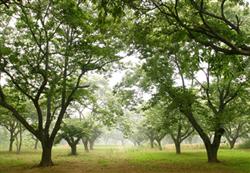Supplement micro-fertilizer to Chinese chestnut after production

The main reason for the low yield and high empty bract rate of chestnut orchard is that it is not applied or sprayed with boron fertilizer in the process of management. When the content of available boron in soil is less than 0.5 parts per million, it will affect the normal fertilization process of Castanea mollissima, resulting in the early stagnation of embryonic development, thus forming the empty bud of Castanea mollissima. In production, we can seize the favorable opportunity from fruit picking to defoliation, and spraying boron micro-fertilizer can promote chestnut flower bud differentiation, improve flower quality and lay a solid foundation for the big weight of chestnut bud in the following year. As a new auxiliary measure of soil fertilization, it has the advantages of simple method, less fertilizer, fast effect, high utilization rate, and is not affected by the redistribution of tree nutrients. 0.2% borax and 0.2% zinc sulfate mixture are often used for foliar spraying. The time should be chosen in the morning when the dew is not dry or in the evening, wet and windless weather is the best. Second, spreading in the rhizosphere. After fruit harvest, at the crown drip line, where the fibrous roots are most distributed, dig a ditch with a length of 0.4 meters and a depth of 0.6 meters, apply boron fertilizer, and then cover the soil with organic fertilizer. The amount of boron application is calculated according to the size of the tree crown, and the boron microelement fertilizer is 10ml 20g per square meter. For example, large fruiting trees can generally apply 100 grams of boron micro-fertilizer, and one soil application of boron has a slight special effect, which has an obvious effect within 5 years. The trees with an empty bract rate of about 50% can change the overall fullness of chestnut and improve economic benefits.
- Prev

Control methods of insect pests in Chinese chestnut
1. Chestnut gall wasp, also known as chestnut tumor peak, adult head and abdomen dark brown, antennae filiform, brown, chest dilated, pitch black, lay eggs in the bud from June to July, and the larvae grow in the bud and overwinter. Spring buds sprout short branches, damaged branches or petioles and other inflated adult galls (tumors), withering branches and leaves and weakening the tree.
- Next

Zinc and Boron should be supplemented in Postharvest Chestnut
At present, the yield of most chestnut orchards is not high, the plant yield is only 4-5 kg. Many Chinese chestnuts hang fruit trees with bracts and no chestnuts (that is, empty buds). The reason is that in addition to extensive management, it has a great relationship with the application of zinc and boron. Practice has proved that the supplementary application and spraying of zinc and boron micro-fertilizer after fruit picking of Chinese chestnut can promote flower, differentiation and improve flower quality.
Related
- Moge, come on! The staff of the peasant association in the producing area of cantaloupe were frightened when the crowd gathered.
- Causes and Solutions of low Fruit setting rate of Apple
- Symptoms and control measures of passion fruit virus disease
- Fruit growing lesson: how do apple orchards keep high yields?
- Can you build orchards in the mountains? What are the pros and cons?
- How to manage the coloring period of Crisson grape?
- This paper introduces the processing technology of two kinds of fig products.
- How much is a month for retired teachers in rural areas by 2020?
- How can strawberry planting increase sugar content? We should pay attention to management in many aspects.
- What are the cultivation techniques on how to improve the yield of golden fruit?

